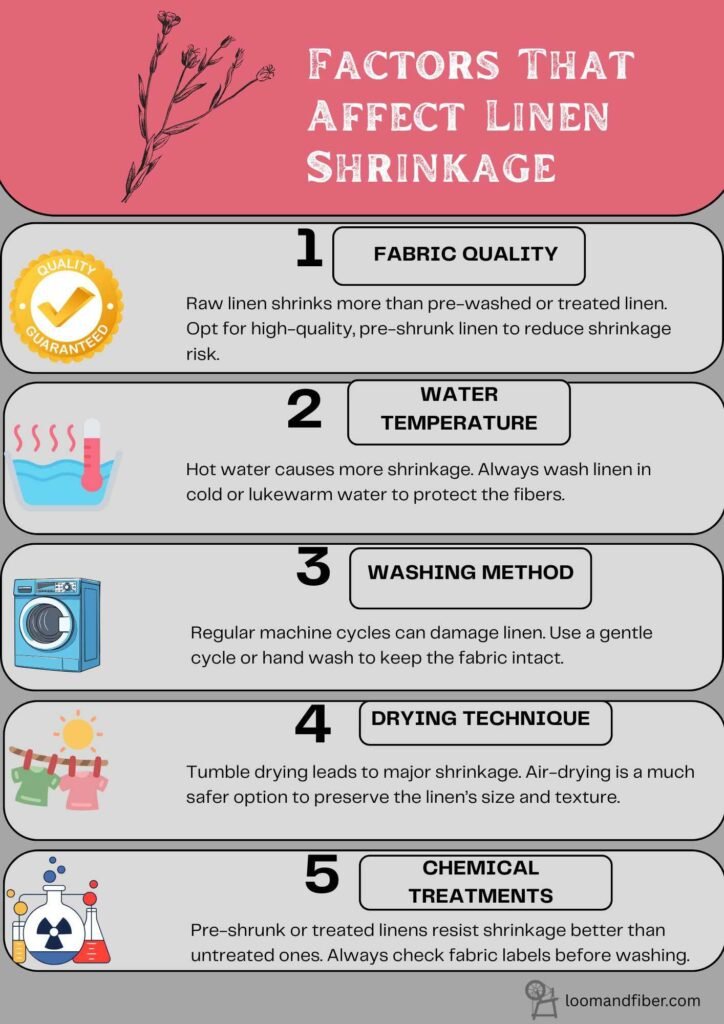Linen is a breathable, long-lasting natural fiber that has stood the test of time. It repels allergens and bacteria, helping it feel clean and gentle against skin. In summer, its moisture-wicking cooling action makes it a go-to choice for clothing and sheets. With each wash, linen becomes softer and more sculpted, suiting both apparel and home decor. When treated with care, linen can easily serve a household for decades. These traits explain why people have cherished linen for thousands of years. This legacy leads to one practical concern: does Linen Fabric shrink when washed? The answer is important because unwanted shrinkage may distort the fit of clothing or curtains. A shirt that draws up in water, for instance, may hang far differently than expected.
During initial processing, linen is stretched; when it encounters water, that tension eases and fibers contract. For this reason, even untreated linen usually loses a small amount of width after the first wash. To limit shrinkage, machine wash on a gentle cycle and tumble dry on low or line dry. In the sections that follow, we quantify typical shrinkage and outline specific habits that extend linen’s remarkable lifespan.
Does Fabric Linen Shrink When Washed?
Answer: Yes – linen tends to shrink a bit the first time it is washed. Indeed, linen normally shrinks somewhere between 3–5% during washing. This normal shrinkage is normally factored into garment sizes, but it is sufficient to observe if not anticipated. However, in extremely hot water or a high-heat dryer, linen may shrink more (up to ~10%). Pre-shrunk or pre-washed linen will shrink very little, as most of the relaxation of the fibers occurs prior to washing it. Essentially, you can anticipate a minor first-washing shrinkage (a couple of percent) unless your linen is already pre-treated.
Factors That Affect Linen Shrinkage
There are various factors that control the degree to which linen will shrink during washing. The most important factors determining linen shrinkage are:

Fabric Quality (pre-washed or raw linen): Unwashed raw linen shrinks the most, while pre-washed or pre-shrunk linen will shrink very little. Most linen goods are marketed pre-treated so that they won’t have huge first-wash shrinkage. Higher-end linens tend to be pre-washed or steamed-treated so that they remain stable, while cheaper or loosely woven linens will probably shrink more.
Fiber Type (linen vs cotton): Linen fibers tend to shrink less than cotton. Cotton textiles shrink around 6–8%, while pure linen usually shrinks by about 3–5%. Indeed, specialists say that linen shrinks slightly less than cotton.
Fiber Content (blends): Blends or blended fibers’ shrinkage indicates the characteristics of all the fibers. Linen-cotton will shrink more if the content of cotton is high. Cotton, for instance, can shrink as high as 6–8%, thus linen-cotton fabrics shrink more compared to 100% linen. Polyester mixed with linen will shrink less, as polyester shrinks less.
Water Temperature: Actually, hot water shrinks linen fibers and can cause them to shrink more. Soaking in water that is too hot or ice-cold water may both disturb linen’s size. It is always advisable to wash linen in lukewarm or cold water to reduce shrinkage
sondeflor.com.
Washing Procedure (machine vs hand): For example, use a gentle washing cycle or wash by hand to decrease agitation. Loading the washing machine too heavily or using an agressive washing cycle can cause twisting and stressing of the fibers, which increases shrinkage. Hand washing in warm water is easier on delicate or older linen pieces and can decrease shrinkage.
Drying Method: High dryer heat is a usual culprit, though, in causing linen shrinkage. Air drying (line drying) is safest. If you do use a dryer, use low heat and take the linen out while it is still a bit damp to avoid over-shrinking.
Chemical Treatment (untreated vs pre-shrunk): Linen that is “pre-washed” or “pre-shrunk” has already had the shrinkage minimized. Untreated linen will shrink along with fiber relaxation during the initial wash. And don’t use bleach or strong chemicals on linen – bleach will degrade the fibers and discolor them. No special soap is required other than a gentle cleanser.
How to Wash Linen to Prevent Shrinkage
Handle linen gently from the start: don’t wash it with heavy stuff like jeans or bath towels-those extras create friction and encourage shrinkage. Also, sort light and dark pieces so stray dye doesn’t ruin anything. For the safest method to wash linen without losing size, stick to these rules:
- Use lukewarm or cold water: Temperatures above 30 degrees Celsius activate shrinkage, so keep the wash cool.
- Gentle cycle or hand wash: Choose the delicates setting, or wash by hand to limit tumbling and twisting that stresses the fibers.
- Mild detergent only: Opt for a linen-friendly detergent and skip bleach, enzymes, or heavy soaps-those weaken the threads and can yellow the fabric. Fabric softener is also pointless, because linen becomes softer with every wash.
- Skip the dryer: After washing, reshape the damp item and let it air-dry, either hung up or laying flat out of direct sun. High-heat tumble drying shrinks linen in a heartbeat.
- Iron damp linen: To remove creases and set seams, press the cloth with a cool iron while it is still slightly wet. The steam relaxes the fibers without forcing them to contract.
Can You Unshrink Linen?
If linen has shrunk, you can sometimes reclaim some of its lost size by reconditioning and gentle stretching.
- Start by soaking the item in lukewarm water mixed with one tablespoon of ordinary hair conditioner; the conditioner relaxes the fibers.
- After fifteen to thirty minutes, press out excess water without wringing and gently stretch the cloth toward its original measurements.
- Let the linen hang or lie flat until it is moistened yet not wet, then steam-iron on low heat, working from the center outward.
- Moisture combined with gentle heat encourages the fibers to settle back closer to their former shape.
Keep in mind that this technique usually recovers a good portion of the lost size but rarely restores the piece to its exact original dimensions.
Common Myths About Linen Shrinkage
Many people carry misconceptions about caring for linen. Lets clear up a few of the most common:
- Myth: Linen never shrinks. False. 100-percent linen shrinks roughly 3 to 4 percent on the first wash unless it is already pre-shrunk.
- Myth: All linen shrinks in the same amount. False. The degree of shrinkage depends on the fabric quality and finishing.
- Pre-washed or loosely woven fabrics lose much less than stiff or untreated yardage.
- Myth: Boiling linen softens it without any downside. Partly true-very hot water can relax fibers, but it also prompts heavy shrinkage. In practice, a boil wash leaves linen smaller than intended.
- Myth: Once linen has shrunk, more washes will stretch it back. False. Most shrinkage occurs during the first wash; extra washes and ironing mainly soften the fabric and do not restore size.
Tips to Maintain Linen Fabric Longevity
To keep your linen looking and feeling its best, follow these tips:

Store it properly. Keep linen in a cool, dry place and never fold or put it away while it is damp or soiled, because the leftover moisture invites mildew. Use breathable storage such as cotton bags or acid-free tissue, rather than plastic, so air can circulate and humidity does not build up.
Wash only when needed. Cleaning too often slowly wears the fibers. Instead of tossing items into the machine after a single use, try hanging them outdoors to air or spot-cleaning trouble spots. Reduced washing cuts down on mechanical stress and keeps the fabric lasting longer.
Handle gently when wet. Resist the urge to wring or twist a soaking piece, because that distorts the weave and breaks threads. Instead, lay the item flat on a towel, roll it into a log shape to absorb excess water, then dry it flat or over a line away from direct sunlight.
Fold or hang carefully. Fold garments along their seams and store them in neat piles, or hang them on wide, padded hangers that distribute weight evenly and avoid stretching. Keep storage boxes and closets organized so each piece has space; overcrowding can crush and misshape the fabric.
Iron on low heat. Work with a low to medium setting while the linen is still slightly damp; the moisture allows the plate to glide smoothly and resets the fibers with minimal stress.
Stain treatment. For spills, first blot the area gently with a soft cloth, then dab the spot with a mild detergent solution on a sponge and rinse quickly. Wash the item as usual, and never scour hard, since vigorous scrubbing can break the delicate fibers.
Keep Linens Bright: Choose a mild, non-chlorine bleach-such as oxygen bleach-to preserve the brightness of white linens. Steer clear of chlorine bleach because it damages fibers over time and can shift the fabric’s color.
Select a Gentle Spin: When washing linen, pick the machines lowest spin setting or, if possible, skip the spin altogether. This approach reduces wrinkles and eases strain on delicate fibers, helping the pieces last longer.
Conclusion-
Does linen Fabric shrink when washed? Yes, it can shrink if mishandled. Yet, washing in cold water, using a gentle cycle, and letting the fabric air-dry will keep linen soft, strong, and true to size.
So don’t let the fear of shrinkage keep you from enjoying this lovely, breathable, and eco-friendly cloth. With a bit of mindful care, your linen garments can serve you well for many seasons.
Do you have your own tips for keeping linen in shape? Share your ideas in the comments or tell us your favorite linen rescue story!
Read More>> About the Shrinkage of Bamboo Fabric and Modal Fabric.
FAQs
Pre-washed linen is far less prone to drastic shrinkage, yet prudent washing habits still matter.
If you tumble dry, use only the low-heat, delicate cycle; line drying remains the safest route.
Expect most linen to contract roughly 3% to 5% after the first wash; untreated cloth can shrink even more. Always check the care label before cleaning.
Heat damage tends to set shrinkage permanently, while minor contraction may relax with the right techniques.
